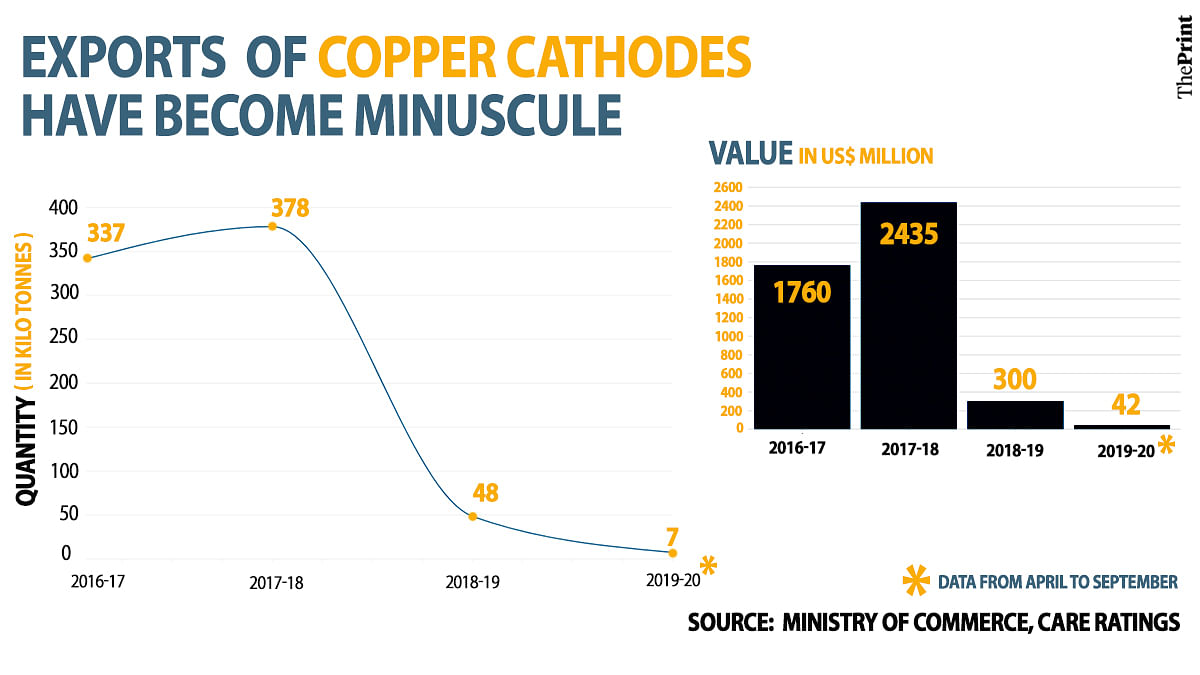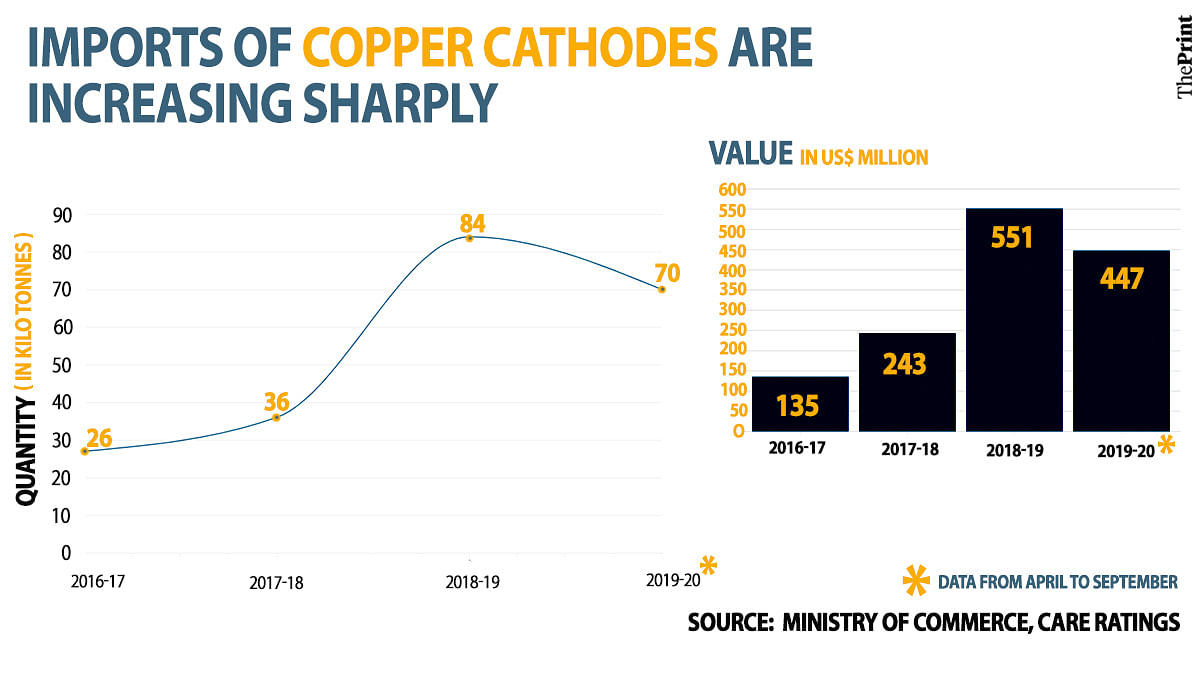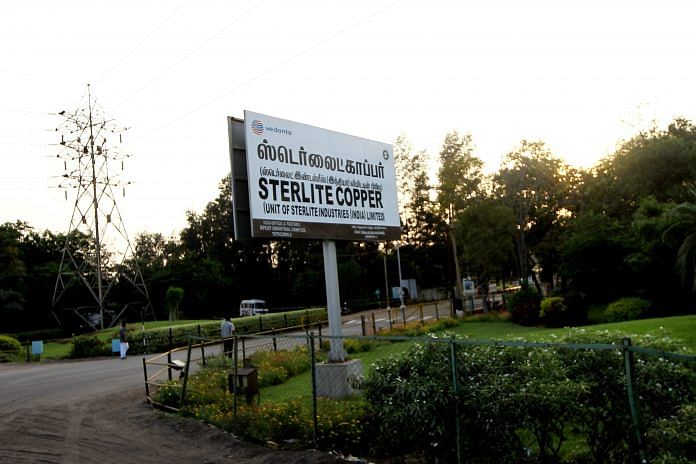New Delhi: India’s copper imports have risen sharply in the last year-and-a-half. So sharply that a country which in 2017-18, was among the top five exporters of copper cathodes became a net importer beginning 2018-19, according to commerce ministry data.
What changed? Vedanta subsidiary Sterlite Copper’s plant in Thoothukudi (earlier known as Tuticorin) was shut down in May 2018 on the orders of the Tamil Nadu government, after violent protests by residents, who alleged that the factory was a health hazard.
Copper is behind only aluminium and steel in terms of its widespread usage — many industries like construction, telecommunications, transportation, consumer durables and automobiles use the material. And the reduction in domestic capacity has forced many Indian manufacturers to look at imports to meet their demands.
Also read: How a small protest in Thoothukudi turned into an explosive cocktail
Net importer after 18 years
The before-and-after figures tell a story — in 2017-18, India exported nearly 378 kilo tonnes of copper cathodes — obtained after copper ore is smelted and refined. But after the closure of the Thoothukudi plant, which had a refining capacity of 400 kilo tonnes, India’s exports plunged to 48 kilo tonnes ($300 million) in 2018-19.
In the first half of the 2019-20 financial year, India has exported only 7 kilo tonnes of copper, worth $42 million.

On the other hand, India had imported just 36 kilo tonnes of copper cathodes in 2017-18, worth $243 million.
The figure went up to 84 kilo tonnes worth $551 million in 2018-19, while in the first half of 2019-20, the country has already imported 70 kilo tonnes of copper cathodes, amounting to $447 million.

India had exported nearly $1.5 billion of copper cathodes to China in 2017-18, but the figure fell to $226 million in 2018-19, an 85 per cent drop. In the first half of this year, India has only exported $39 million worth of copper cathodes to China.
On the import front, India has mostly bought copper cathodes from Japan — worth $390 million in 2018-19 and $384 million already in April-September 2019.
Ratings agency CARE said in a September 2019 report: “Production fell by 46.1 per cent during FY19 due to the permanent closure of Sterlite’s 400KT copper factory in Thoothukudi (formerly known as Tuticorin) on 28 May 2018. The Tuticorin smelter accounts for 40 per cent of the country’s copper smelting capacity.
“India used to be a net exporter of copper cathodes till FY18. Now with the closure of the Tuticorin smelter, the drop in domestic production has led to the domino effect of increasing the country’s imports and decreasing its exports. India has become a net importer of refined copper after 18 years.”
Ajay Sahai, director general and CEO of the Federation of Indian Export Organisations, also said the closure of the Sterlite factory in Tamil Nadu was the main reason why copper cathodes exports have fallen.
“India was among the top five exporters of copper cathodes until two years back,” he said.
Also read: Sterlite copper plant to stay shut in Tamil Nadu as Supreme Court sets aside NGT order
Current status of the plant
Vedanta has appealed against the Tamil Nadu government’s decision and the matter is pending in court.
In its presentation after the declaration of the second quarter results, Vedanta Ltd said the operations are under “force majeure”, and that the firm has not utilised $519 million of the $717 million capex allocated for the project.
In an interview in June, Vedanta chairman Anil Agarwal estimated that the firm had lost about $200 million in profits on account of the plant shutdown.
Also read: Vedanta says it has permission to expand in Thoothukudi, activists say no
Bleak outlook
Analysts predict that India will continue to remain a net importer of copper cathodes, given that the steadily increasing domestic demand will not be met by the local production capacity.
CARE Ratings estimates that the domestic refined copper demand will increase by 7-8 per cent by the end of the current fiscal, led by the growing demand from the power sector, renewable energy, consumer durables and hybrid and electric cars.
“Due to the increase in demand, India will continue being a net importer of refined copper during FY20 as well, unless the Madurai court passes the judgement for the remission of the Tuticorin smelter,” it said.
Also read: Vedanta seeks TN govt nod to repair ‘crumbling’ Sterlite Copper smelter




Anything the south does, is not good as prer the Delhi and other Northern parties. One can never stop a idiot shooting his foot.
Hey man! why are you faulting the Central Govt? Blame the DMK, The Commies and the Christian Missionaries who fund all this fiasco. DMK doesn’t want Thamizh Nadu prosper; Stalin wants to become CM by hook or crook. That was why he has hired a high-priced BRAHMIN consultant from UP (Yes! a Brahmin, whom Stalin/DMK/DK detest and bad-mouth)!!
Bitter true of life is economic prosperity is vital for growth otherwise live like supressed by west countries, china, saudi, or any. Here some want to go back to wild life. If you have to survive you need money to eat to drink and to feel comfort, without this no sense of evolution.
Instead of shutting employment, people must protest for better treatment before waste disposal or force company to do that rather shut plant.. This kind of protest show lack of technological awareness that with technology this can be cure. People know rights but not duties.
The article is good on statistics but falls short on
1. Why there are no protests about environment against Birla Copper ? Both Sterlite n Birla use the same/similar Copper Concentrates so what is the difference?
2. Copper manufacturers in India have been protected for a good period with high import duties for similar products from international companies..why then are Indian copper companies not competitive
3. It is also a fact that copper concentrates is 100% imported that means there is an out go of forex besides that the quality of copper concentrates is not what it was earlier in terms of impurity levels…Do the Indian copper companies have the requisite technology to smelt low grade concentrates
..the government should give an import duty benefit of 0% or confessional duty only if concentrate chemistry is defined clearly and is inspected by Government agencies st discharge port
India has no sizeable copper ore deposits. The Vedanta plant at Tuticorin was importing copper ore from Australia. Now instead of copper ore, copper is being imported. To find whether the plant closure has turned India into a net importer you need find the difference in cost of imports of copper ore and copper, also assign a cost to the pollution caused by the plant and the cost on public health. This is a shallow one sided article.
India has no sizeable copper ore deposits. The Vedanta plant at Tuticorin was importing copper ore from Australia. Now instead of copper ore, copper is being imported. To find whether the plant closure has turned India into a net importer you need find the difference in cost of imports of copper ore and copper, also assign a cost to the pollution caused by the plant and the cost on public health. This is a shallow one sided article.
Well said one has to weigh the damage to the mother Earth and public health environmental degradation which is more in terms of loss compare to the figures which have been published.
This is the age old story of India – industry vs people conflict. A culture has been created in this country where industry and entrepreneurs are always viewed with suspicion. And as this story shows the outcome is usually negative for everybody – people lost jobs, factory closed leading to losses and India is importing cooper. We need to find out win-win solutions.
Go into details, some political party did not get it’s due. Even Nokia had to shut down because of politics.
shame on your article
The main culprits behind this are the innumerable Christian missionary groups that have a free hand to TN. Most of these are well funded by various vested interests in the west and China to subervert the Indian economy. Shutting down the the primary source of copper that is so vital to our development is akin to amputating the leg to cure a small itch in the foot. The corrupt politicians and officials who should have made the plant comply with environmental regulation have fine scot free while tens of thousands have been thrown out of jobs. This is mess that various proselytising religious outfits want. To convert poor people by buying them for money.
This is all rubbish. Pls stop politicking. Better shed light on what are the environmental issues and how they are proposed to be addressed in the short term and long run.
You won’t get a buy-in from the general public unless facts and both sides of arguments are analysed and discussed,
Even before the factory started, I am very surprised that they didn’t do an “Impact Assessment” regarding pollution, etc., and how to ameliorate those problems. If they had done a due-diligence, all these problems wouldn’t have happened. Of course, the fringe elements supported by the Christian Missionaries made sure to close the plant just to insult Mr. Modi.
The before-and-after figures tell a story — in 2017-18, India exported nearly 378 kilo tonnes of copper cathodes — obtained after copper ore is smelted and refined. But after the closure of the Thoothukudi plant, which had a refining capacity of 400 kilo tonnes, India’s exports plunged to 48 kilo tonnes ($300 million) in 2018-19.
It is true that India will utilise only 22 kilo tonnes of copper from sterlite plant if all copper plants export are stopped as per calculation in 2017-18.
India can very well import required copper then having a illegal copper plant in India. Why people are crying for decrease in copper export. If you can import food products like apple Alu onion chocolates etc then we can very well import copper also
It only the fault of politicians who ruled tamilagam.
Since they have not implementing to eradicate environmental hazards
This happened.
If they followed the environmental rules strictly from hazards will not happen.
If the politicians and officials are good the pollution might not happened.
In Tirrupur the same pollution problem is there.
But so far no remedies.
there are no way to eradicate environmental hazards, either some of you suffer or some of you gain, and the sad thing everything is based on economy progress
I suppose, you could also mention dozens of death caused by pollution of Sterilite (official figures), aside from dozens more deaths caused by massacre by police during protests. And also, that it was fined for at least 100 crore and was banned by central, state regulatory bodies, courts, etc and then allowed later.
Stupid article….why don’t they suggest something lik having a plant which doesn’t pollute – as they do in advanced countries. Would the author relocate next to the plant, I wonder…
It is widely known in press that China government is financially supporting the group in tamilnadu to agitate against the sterlite. The anyi-national and anti-hindu groups are always after some issue or other to raise their voice. Now they got funding also. Thus the sterlite is due was blown out of proportions and sterlite is hanging. Nobody did work out what us the total job loss gown the line because of sterlite closure in the industries for which sterlite was the main supplier of raw material like copper, sulphuric acid etc.
The National Environmental Research Institute (NEERI) and the TNPCB have found evidence that Sterlite contaminated the groundwater, air and soil with its effluents and also violated standards of operation.[2]
In 2010, the Madras High Court had ordered a shut down of the same plant, for violating environmental regulations which was subsequently challenged by the group in the Supreme Court.[9] The Supreme Court, in April, 2013 struck down the Madras high court’s order[2] and instead fined Sterlite Rs 100 crore for polluting the environment and for operating the plant without a renewal of the consents by TNPCB.[8] Post a favorable ruling by the National Green Tribunal, the plant soon reopened.[2]
It should be relocated to some inhabited area ,stretch of land and should be reopened as soon as possible
Public health is more important than being a importer or exporter-Biased media- shame on ur article
Why can’t media create a hype for immediate disposal of case. Hardly found anyone talking about it.
The plant could be relocated to some remote uninhabited area. We cannot play with people’s lives just for the sake of monetary gain. There could be some ulterior motive to this article.
The reason you end up appreciating the likes of China is because they confine such useless protests to dumpsters.
Development has its own hazards.There is no denying Politicking has always been over people’s shoulders.The gain is for politicians and loss if any is to public account.